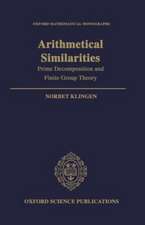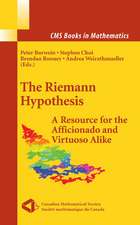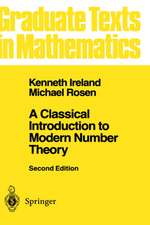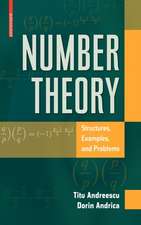Elliptic Functions: Grundlehren der mathematischen Wissenschaften, cartea 281
Autor Komaravolu Chandrasekharanen Limba Engleză Hardback – sep 1985
| Toate formatele și edițiile | Preț | Express |
|---|---|---|
| Paperback (1) | 482.74 lei 6-8 săpt. | |
| Springer Berlin, Heidelberg – 28 iun 2012 | 482.74 lei 6-8 săpt. | |
| Hardback (1) | 585.73 lei 6-8 săpt. | |
| Springer Berlin, Heidelberg – sep 1985 | 585.73 lei 6-8 săpt. |
Din seria Grundlehren der mathematischen Wissenschaften
-
 Preț: 353.84 lei
Preț: 353.84 lei - 24%
 Preț: 728.15 lei
Preț: 728.15 lei -
 Preț: 410.22 lei
Preț: 410.22 lei - 24%
 Preț: 587.88 lei
Preț: 587.88 lei - 17%
 Preț: 498.74 lei
Preț: 498.74 lei -
 Preț: 592.77 lei
Preț: 592.77 lei - 20%
 Preț: 692.50 lei
Preț: 692.50 lei - 24%
 Preț: 893.31 lei
Preț: 893.31 lei - 20%
 Preț: 824.75 lei
Preț: 824.75 lei - 24%
 Preț: 632.98 lei
Preț: 632.98 lei - 15%
 Preț: 596.69 lei
Preț: 596.69 lei - 15%
 Preț: 714.49 lei
Preț: 714.49 lei -
 Preț: 333.03 lei
Preț: 333.03 lei - 15%
 Preț: 473.16 lei
Preț: 473.16 lei -
 Preț: 356.49 lei
Preț: 356.49 lei -
 Preț: 484.43 lei
Preț: 484.43 lei - 15%
 Preț: 452.79 lei
Preț: 452.79 lei -
 Preț: 456.66 lei
Preț: 456.66 lei - 15%
 Preț: 708.75 lei
Preț: 708.75 lei -
 Preț: 423.08 lei
Preț: 423.08 lei - 15%
 Preț: 444.29 lei
Preț: 444.29 lei - 15%
 Preț: 527.79 lei
Preț: 527.79 lei - 15%
 Preț: 589.65 lei
Preț: 589.65 lei -
 Preț: 353.40 lei
Preț: 353.40 lei - 18%
 Preț: 727.66 lei
Preț: 727.66 lei -
 Preț: 387.96 lei
Preț: 387.96 lei - 15%
 Preț: 454.74 lei
Preț: 454.74 lei - 15%
 Preț: 481.03 lei
Preț: 481.03 lei -
 Preț: 464.55 lei
Preț: 464.55 lei -
 Preț: 348.77 lei
Preț: 348.77 lei -
 Preț: 362.04 lei
Preț: 362.04 lei -
 Preț: 488.12 lei
Preț: 488.12 lei - 15%
 Preț: 447.57 lei
Preț: 447.57 lei -
 Preț: 419.81 lei
Preț: 419.81 lei -
 Preț: 388.52 lei
Preț: 388.52 lei -
 Preț: 419.21 lei
Preț: 419.21 lei - 15%
 Preț: 581.01 lei
Preț: 581.01 lei -
 Preț: 497.75 lei
Preț: 497.75 lei -
 Preț: 360.53 lei
Preț: 360.53 lei -
 Preț: 387.75 lei
Preț: 387.75 lei -
 Preț: 419.81 lei
Preț: 419.81 lei - 18%
 Preț: 725.75 lei
Preț: 725.75 lei -
 Preț: 453.78 lei
Preț: 453.78 lei -
 Preț: 386.39 lei
Preț: 386.39 lei
Preț: 585.73 lei
Preț vechi: 689.09 lei
-15% Nou
Puncte Express: 879
Preț estimativ în valută:
112.08€ • 119.85$ • 93.45£
112.08€ • 119.85$ • 93.45£
Carte tipărită la comandă
Livrare economică 17 aprilie-01 mai
Preluare comenzi: 021 569.72.76
Specificații
ISBN-13: 9783540152958
ISBN-10: 3540152954
Pagini: 208
Ilustrații: XI, 192 p.
Dimensiuni: 156 x 234 x 17 mm
Greutate: 0.47 kg
Ediția:1985
Editura: Springer Berlin, Heidelberg
Colecția Springer
Seria Grundlehren der mathematischen Wissenschaften
Locul publicării:Berlin, Heidelberg, Germany
ISBN-10: 3540152954
Pagini: 208
Ilustrații: XI, 192 p.
Dimensiuni: 156 x 234 x 17 mm
Greutate: 0.47 kg
Ediția:1985
Editura: Springer Berlin, Heidelberg
Colecția Springer
Seria Grundlehren der mathematischen Wissenschaften
Locul publicării:Berlin, Heidelberg, Germany
Public țintă
ResearchCuprins
I. Periods of meromorphic functions.- § 1. Meromorphic functions.- § 2. Periodic meromorphic functions.- § 3. Jacobi’s lemma.- § 4. Elliptic functions.- § 5. The modular group and modular functions.- Notes on Chapter I.- II. General properties of elliptic functions.- §1. The period parallelogram.- § 2. Elementary properties of elliptic functions.- Notes on Chapter II.- III. Weierstrass’s elliptic function ?(z).- §1. The convergence of a double series.- § 2. The elliptic function ?(z).- § 3. The differential equation associated with ?(z).- § 4. The addition-theorem.- § 5. The generation of elliptic functions.- Appendix I. The cubic equation.- Appendix II. The biquadratic equation.- Notes on Chapter III.- IV. The zeta-function and the sigma-function of Weierstrass.- § 1. The function ?(z).- §2. The function ?(z).- § 3. An expression for elliptic functions.- Notes on Chapter IV.- V. The theta-functions.- §1. The function ?(?, ?).- § 2. The four sigma-functions.- § 3. The four theta-functions.- § 4. The differential equation.- § 5. Jacobi’s formula for ?’ (0, ?).- § 6. The infinite products for the theta-functions.- § 7. Theta-functions as solutions of functional equations.- § 8. The transformation formula connecting ?3(v, ?) and ?3(?, ?1/?) ..- Notes on Chapter V.- VI. The modular function J(?).- § 1. Definition of J(?).- § 2. The functions g2(?) and g3(?).- § 3. Expansion of the function J(?) and the connexion with theta-functions.- § 4. The function J(?) in a fundamental domain of the modular group ..- § 5. Relations between the periods and the invariants of ?(u).- § 6. Elliptic integrals of the first kind.- Notes on Chapter VI.- VII. The Jacobian elliptic functions and the modular function ?(?).- § 1.The functions sn u, en u, dn u of Jacobi.- § 2. Definition by theta-functions.- § 3. Connexion with the sigma-functions.- § 4. The differential equation.- § 5. Infinite products for the Jacobian elliptic functions.- § 6. Addition-theorems for sn u, cn u, dn u.- § 7. The modular function ?(?).- §8. Mapping properties of ?(?) and Picard’s theorem.- Notes on Chapter VII.- VIII. Dedekind’s ?-function and Euler’s theorem on pentagonal numbers.- § 1. Connexion with the invariants of the ?-function and with the theta-functions.- § 2. Euler’s theorem and Jacobi’s proof.- § 3. The transformation formula connecting ?(z) and ?(?½).- §4. Siegel’s proof of Theorem 1.- §5. Connexion between ?(z) and the modular functions J(z), ?(z).- Notes on Chapter VIII.- IX. The law of quadratic reciprocity.- § 1. Reciprocity of generalized Gaussian sums.- § 2. Quadratic residues.- §3. The law of quadratic reciprocity.- Notes on Chapter IX.- X. The representation of a number as a sum of four squares ..- §1. The theorems of Lagrange and of Jacobi.- § 2. Proof of Jacobi’s theorem by means of theta-functions.- §3. Siegel’s proof of Jacobi’s theorem.- Notes on Chapter X.- XI. The representation of a number by a quadratic form.- §1. Positive-definite quadratic forms.- § 2. Multiple theta-series and quadratic forms.- § 3. Theta-functions associated to positive-definite forms.- § 4. Representation of an even integer by a positive-definite form.- Notes on Chapter XI.- Chronological table.
Recenzii
"...In the breadth, depth and inevitability of treatment of this beautiful material, the author has made a contribution to the mathematical community consistent with the distinction of his career. That he has succeeded in compressing this treatment into a succinct monograph of fewer than 190 pages is a testament to his taste, discipline and powers of exposition."-- MATHEMATICAL REVIEWS


















